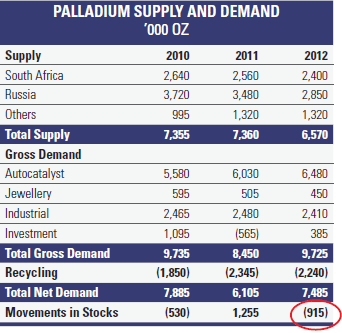On the demand side, platinum has benefitted from a steady demand for auto catalysts, which constitutes the metal's primary industrial usage. Platinum and palladium both possess chemical properties that help reduce pollutants produced by gasoline and diesel engines, significantly lowering the air pollution produced by automobiles. Just as we believe the platinum price must go up to incentivize new mine production out of South Africa, the platinum price is further supported by the fact that it CAN go up, because of the relative inelasticity of the demand for its catalytic utility. The average automobile (worldwide) carries a mere $212 worth of platinum group metals per vehicle, making the impact of any platinum price increase on the total wholesale cost of an automobile relatively marginal.7 In China, for example, where pollution is a critical problem, air pollution levels of 300 or above regularly prompt the US embassy to issue warnings to minimize outdoor or strenuous activity. Air particulate levels in Beijing have often been above 500 recently, sometimes crossing over 700. In response, Beijing has recently tightened emissions standards for new cars to meet European Union Standards, or Euro V, starting February 1st.8 Increasing the platinum/palladium loadings per catalytic converter is one feasible way of directly addressing this growing problem, as the demand for automobiles in China is expected to grow steadily over the next five years. Platinum has also benefitted from increasing demand for its usage in jewelry, particularly in China, where it is considered to be superior to gold. According to refiner Johnson Matthey, China is expected to have consumed 1.92 million ounces of platinum in 2012, representing 70% of the overall global platinum jewellery consumption of 2.73 million ounces.9 That total is likely to increase as demand rises in other countries as well. In India, for example, platinum demand is estimated to have increased by 25% this past year, representing a new high of 100,000 ounces.10 As emerging markets growth continues, we expect platinum jewellery demand to increase along with it.
PALLADIUM
The palladium story is similar to that for platinum from a demand perspective, but has a different supply picture that makes it more compelling in our view. Palladium generally occurs with platinum and other PGM metals and is usually associated with nickel and copper. Like platinum, palladium's main industrial usage is in catalytic converters, most notably in gasoline engines. It is also used in jewellery, watchmaking, dentistry, surgical instruments and electrical contacts.
Almost 40% of the world's annual palladium mine supply comes from Russia, primarily through operations at Norilsk. Russia, naturally, does not provide much information on its palladium stockpiles, but various reporting agencies are able to piece together reliable estimates for annual supply and demand.
The palladium market is tight, and appears to be getting tighter. It has gone from a 1.26 million ounce surplus in 2011 to a 915,000 ounce deficit in 2012. This represents a swing of over 2 million ounces this year due to contracting supply, increasing gross demand and diminished recycling, resulting in a supply decrease of 790,000 ounces (see Figure E). If you factor in the ~200,000 ounces we purchased in our Trust, the deficit for 2012 increases to 1.15 million oz.11
As bullish as we are on the supply dynamics of platinum, it is palladium that appears to be poised to move higher in the short-term. The palladium market is now in supply deficit globally and will experience a residual deficit in 2013 even after existing stockpile sales are taken into account. Russia has historically maintained a sizeable palladium stockpile which has represented a key source of supply over the past two decades. 2012 reports suggested that that stockpile was nearing depletion, with sales expected to fall below 100,000 ounces in 2013, versus the 250,000 ounces that are believed to have been sold last year.12 Those numbers were also supported by Swiss PGM data, where the most recent 2012 numbers show Russian palladium shipments running 72% lower than the same period in 2011.13 All of this was recently confirmed by Norilsk itself, when an executive conceded in an interview on November 29th (and later confirmed by industry watchers like GFMS this past January) that the supply overhang from Russian stockpiles is officially close to being depleted. If this proves to be true, it will represent a significant shift in supply, since those stockpiles were a main contributor in balancing the palladium market for the last ten years.
FIGURE E

Source: Johnson Matthey Platinum 2012 Interim Review
One other bullish palladium supply factor relates to the Norilsk mines themselves, which produce more palladium than the next four largest palladium producers combined. Norilsk's 2012 palladium production is expected to account for 42% of global supply. Despite higher prices, Norilsk is not expected to expand its annual palladium production for at least 10 years, because that's how long it will take to develop the new mines it requires to increase production. In addition, the existing operations are reported to be having difficulty maintaining their average 2.7 million ounces of annual production due to diminishing ore grades at depth within the ore bodies Norilsk is mining. With Russian state supplies dwindling, and Norilsk's palladium production flat at best, the supply picture in 2013 has a very high probability of tightening further. This is especially likely if South Africa's 1.5 million ounces of palladium production is also impacted by further strikes and mine shutdowns.
Palladium demand has been robust, having risen by 15% year-over-year in 2012 to 9.73 million ounces.14 The growth has been primarily driven by increased use in autocatalysts, the demand for which alone is forecasted to increase by 7% in 2013. Given the probability of tightening supply in the years ahead, we could potentially see a hoarding reaction by industry users as supply constraints become more pronounced. In year 2000, a similar reaction by industry users led palladium to trade over $1,000/ ounce. It is also interesting to note that palladium has the second highest amount of short positions in the futures market in relation to total annual production - second only to that for silver. The reversal of those short contracts may represent a significant source of investment demand as prices continue to rise.15
SUMMARY
The timing of the launch of the Sprott Physical Platinum & Palladium Trust has been favourable thus far. Supply problems out of South Africa will be the driving force behind platinum's price appreciation, while palladium will benefit from the depletion of Russian stockpiles and flat production from Norilsk. Both metals have the potential to see significant demand increases as the autocatalyst market benefits from growing global auto sales, which reached a record 80 million units sold in 2012.
As at February 2013, the Sprott Physical Platinum & Palladium Trust now holds 81,486 ounces of platinum and 186,098 ounces of palladium in bullion form. The Trust is structured similar to our existing Sprott Physical Gold Trust (NYSE Arca: PHYS, TSX: PHY.U) and Sprott Physical Silver Trust (NYCE Arca: PSLV, TSX PHS.U), but differs in that it initially holds approximately equal dollar amounts of platinum and palladium.
We aim to publish more updates in the coming months to analyze developments in the markets for both metals. Although platinum and palladium share gold and silver's "precious metal" categorization, they represent significantly smaller markets in terms of physical production, making them much more responsive to the supply constraints and demand increases that we foresee for both. It is also worth noting that relatively little of the total annual platinum and palladium supply actually makes it to "market" - with the vast majority sold directly to fabricators. Our Trust's December purchases represent 1.3% of 2012's platinum mine supply and almost 3% of palladium supply. If investment demand for platinum/palladium were to grow in an environment where supply is further constrained, it could indeed have a large impact on the spot price for both metals going forward.
Precious metal investors are encouraged to review platinum and palladium's unique supply/demand dynamics. We believe 2013 will be an exciting year for both metals, and that's without even considering what could happen to the precious metals sector as a whole.













